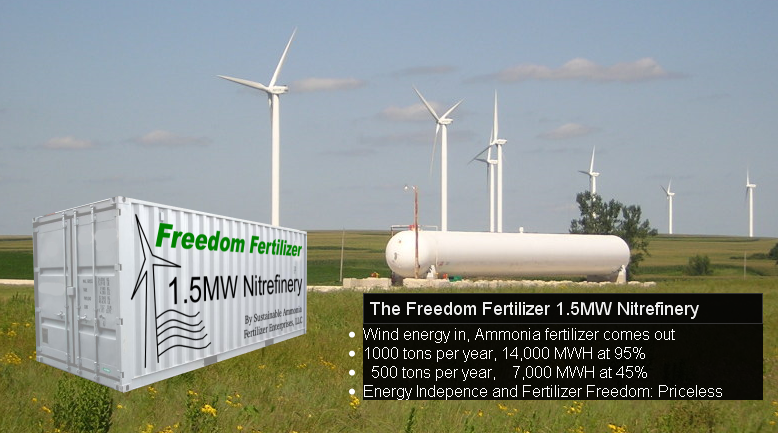Because it’s harder to find info on the Freedom Fertilizer project, allowing farmers to generate their own fuel and fertilizer using wind energy, we copy text from Relocalize.net.
Below text talks about projections, expectations, but the project was executed and a generation site was build. The website freedomfertilizer.com is now offline (taken over by some other thing). Below an image of some of the installation :

Making Iowa farms energy self-sufficient
Sun, 2008-06-01 19:43 — freedomfertilizer
There is a lot of talk of making Iowa farms energy self-sufficient using biomass feedstock these days. Doing this would have to cut into food production. And in todays world doing this is going to be a very tough sell. The energy returned on energy invested (EROEI) of corn ethanol (1.3) means that a farm can never reach the factor of 2x EROEI if it only produces corn for ethanol. A method with an EROEI of 4 would require half the land to be used for energy, cutting the food supply in half. On the other hand, wind farms or solar collectors can use land more efficiently for energy production and would not cut into food production nearly as much. In the case of Freedom Fertilizer’s goals and plans not at all.
One further way to look at this: Iowa is devoting about a quarter of its corn crop to making around 2 billion gallons of ethanol or about 160 billion MJ of energy a year. The installed wind capacity in Iowa is about 1.3 GW and this represents about 0.6% of Iowa’s wind potential. But, already, wind is producing 12 billion MJ/yr in Iowa (30% capacity factor). So, if Iowa used just 10% of its wind potential, it would produce as much useful energy as using all of its corn for ethanol since ethanol is burned at about 30% efficiency.
Not all of Iowa has class 3 or better wind, yet in terms of energy production, the state would do much better promoting wind production rather than with ethanol. But we must make good with what we now have. That is an already installed corn/ethanol production capacity that requires fossil fuel to operate from seed to harvest and harvest to fuel tank. Or does it? Adopting the ideas and goals of Freedom Fertilizer would mean being capable of harvesting a larger percentage of the entire states wind capacity. 50% of Iowa’s estimated wind production that would be 1 trillion MJ/yr. 6.5 times the energy of ethanol produced. Subtract the energy (Fossil fuel) used to produce ethanol, 120 billion MJ/yr leaving only 40 million green MJ/yr net gain from 25% of the states corn harvest that is converted to ethanol. While meeting a Freedom Fertilizer goal would mean 25X the green energy harvested using only 1/2 of the states wind resources.
Freedom Fertilizer’s concepts and goals of making green fertilizer and fuel can make this even better. By converting this states wind energy into storable NH3 we can replace the corn’s nitrogen fertilizer made from fossil fuel and the fossil diesel fuel used to plant, cultivate, harvest and ship this crop to the ethanol plant. Completing a full circle of production using 100% renewable, sustainable, locally made and reliable green fertilizer and fuel. This is only a part of the full Freedom Fertilizer concept, Making all of ethanols 160 MJ of energy content produced in Iowa green MJ
.
How much would this NH3 cost on a per ton or per equivalent gallon basis? Our estimates are quite surprising. Using newly developed technology (Solid State Ammonia Synthesis) created by our associates NHthree. Ammonia can be produced from wind power or any other renewable resource (hydro solar, geothermal, ocean current or off peak grid electricity). This process is particularly appealing to stranded resources that could not be developed or connected to the grid. NH3 produced with the SSAS process would cost approximatively $100 per ton per 1cent KW cost of electricity. In other words 4-cent KW power would equal $400 per ton NH3.
For a equivalent fuel basis. $400 per ton NH3 would be equal to $2.60 a gallon diesel. And how do we use NH3 as fuel. Actually very simply. Ammonia has a high auto ignition temperature (high octane rating) and a low flame speed. It has a critical temperature of 132.4°C which means that above this temperature it is a gas no matter what pressure it is under. The high auto-ignition temperature allows us to use very high compression ratios that boost efficiency. The slow flame speed means the fuel is thus better suited for compression ignition (as in diesel engines). The low critical temperature from the compression of NH3 makes it impractical for it be directly injected into the cylinders as a liquid. So ammonia must be introduced into the induction manifold behind a turbocharger where it vaporizes. The key to simple operation is dual fuel. Starting a diesel engine on diesel fuel and then introducing the vaporized gas into the manifold on a computer controlled basis. Running an engine on a blend of NH3 and biodiesel of up to 95%. The roll of the biodiesel is to act as an igniter and lubricator.
Freedom Fertilizer may not have all of the answers to making Iowa farms totally energy self-sufficient but we challenge anyone else to come up with a better plan that is greener or easier to implement. If we are to prosper in this state and make the best use of the resources available to us we must do it quickly and wisely.
Steve Gruhn
Freedom Fertilizer
3006 Hwy
71
Spirit Lake,
IA 51360
712-330-3114